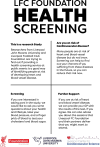Is sports-branded screening effective in identifying adults at greatest risk of developing cardiovascular disease: a convergent parallel mixed-methods design to identify adults at greatest risk of developing cardiovascular disease using an opportunistic sports-branded health screening approach in the community
- PMID: 40139712
- PMCID: PMC11950929
- DOI: 10.1136/bmjopen-2024-087974
Is sports-branded screening effective in identifying adults at greatest risk of developing cardiovascular disease: a convergent parallel mixed-methods design to identify adults at greatest risk of developing cardiovascular disease using an opportunistic sports-branded health screening approach in the community
Abstract
Objectives: To establish whether sports-branded screening is effective in identifying adults at risk of developing cardiovascular disease (CVD); to determine whether the public would engage with sports-branded health screening and what their experiences were.
Design: Convergent parallel mixed methods.
Setting: Mass screening at Liverpool Football Club Foundation events at four community centres.
Participants: 100 participants (mean age 46.6 years (SD 14.7), range 20-84 years) were recruited, and their risk factors were identified. Of these, 62 were screened for their SCORE 2 CVD risk. Men and women were equally represented. Participants were predominantly white British (93%).
Interventions: A dedicated screening area was established at each venue. Data to calculate SCORE 2/OP risk scores were captured (gender, smoking status, age, blood pressure and lipids). Additional risk factors (glucose, incident atrial fibrillation and body mass index (BMI)) were measured to assess wider heart health. A purposive sample of 12 participants participated in a semistructured, one-to-one audio recorded interview about their experience.
Primary and secondary outcome measures: Outcomes were the SCORE 2 and SCORE 2/OP risk tool; ability to recruit participants and whether sports-branded screening was acceptable to participants.
Results: Participants ranged from 20 to 84 years with a mean age of 46.6 years. Men and women were equally represented. Participants were predominantly white British, with 41% and 40% recording a higher than normal total cholesterol and low-density lipoprotein cholesterol (LDL-C) level, respectively, and 36% recording lower than normal LDL-C level. 20% of participants recorded a blood pressure greater than 140/90 mm Hg and 21% of participants were smokers. Mean BMI was 29, ranging from 17.8 to 51, with 70% of the participants classified as overweight or obese. CVD risk ranged from <1% to 15%. 21 participants had a 10-year risk of fatal and non-fatal CVD events greater than the estimated risk for their age. Participants reported that they would not have organised a GP health check or had struggled to book a GP appointment and found mass testing to be convenient, quick and easy.
Conclusions: Sports-affiliated branding was well received and identified a significant number of people with high 10-year risk of CVD plus additional risk factors. All participants interviewed spoke positively about the experience. Immediately providing results, alongside individualised health promotion, allowed participants to understand their risk of CVD and the need for a change of lifestyle.
Keywords: Cardiovascular Disease; Mass Screening; Risk Factors.
© Author(s) (or their employer(s)) 2025. Re-use permitted under CC BY-NC. No commercial re-use. See rights and permissions. Published by BMJ Group.
Conflict of interest statement
Competing interests: None declared.
Figures
Similar articles
-
Diabetes and cardiovascular disease risk screening model in community pharmacies in a developing primary healthcare system: a feasibility study.BMJ Open. 2019 Nov 10;9(11):e031246. doi: 10.1136/bmjopen-2019-031246. BMJ Open. 2019. PMID: 31712336 Free PMC article.
-
New era, new GOALs: cardiovascular screening and lipid management in cystic fibrosis.Ther Adv Respir Dis. 2025 Jan-Dec;19:17534666251317200. doi: 10.1177/17534666251317200. Ther Adv Respir Dis. 2025. PMID: 39891563 Free PMC article.
-
Cardiovascular risk screening program in Australian community pharmacies.Pharm World Sci. 2010 Jun;32(3):373-80. doi: 10.1007/s11096-010-9379-8. Epub 2010 Mar 10. Pharm World Sci. 2010. PMID: 20217476
-
Behavioral and Pharmacotherapy Weight Loss Interventions to Prevent Obesity-Related Morbidity and Mortality in Adults: An Updated Systematic Review for the U.S. Preventive Services Task Force [Internet].Rockville (MD): Agency for Healthcare Research and Quality (US); 2018 Sep. Report No.: 18-05239-EF-1. Rockville (MD): Agency for Healthcare Research and Quality (US); 2018 Sep. Report No.: 18-05239-EF-1. PMID: 30354042 Free Books & Documents. Review.
-
Mobile phone-based interventions for improving adherence to medication prescribed for the primary prevention of cardiovascular disease in adults.Cochrane Database Syst Rev. 2021 Mar 26;3(3):CD012675. doi: 10.1002/14651858.CD012675.pub3. Cochrane Database Syst Rev. 2021. PMID: 33769555 Free PMC article.
References
-
- World Health Organisation World Health statistics: monitoring health for the SDGs (Sustainable Development Goals) 2020. https://digitalcommons.fiu.edu/cgi/viewcontent.cgi?article=1547&context=... Available.
-
- British Heart Foundation UK Factsheet. 2024. www.bhf.org.uk/-/media/files/for-professionals/research/heart-statistics... Available.
-
- Piepoli MF, Hoes AW, Agewall S, et al. 2016 European Guidelines on cardiovascular disease prevention in clinical practice: The Sixth Joint Task Force of the European Society of Cardiology and Other Societies on Cardiovascular Disease Prevention in Clinical Practice (constituted by representatives of 10 societies and by invited experts)Developed with the special contribution of the European Association for Cardiovascular Prevention & Rehabilitation (EACPR) Eur Heart J. 2016;37:2315–81. doi: 10.1093/eurheartj/ehw106. - DOI - PMC - PubMed
MeSH terms
LinkOut - more resources
Full Text Sources
Miscellaneous


